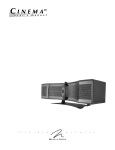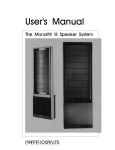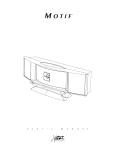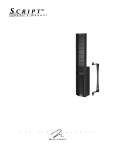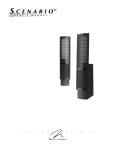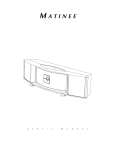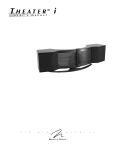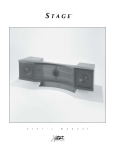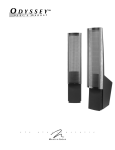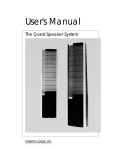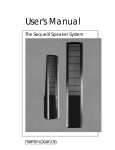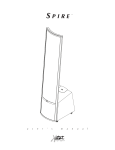Download MartinLogan Center Channel Speaker Logos User`s manual
Transcript
User's Manual The Logos Center Channel Important Contents Your Logos speaker is provided with an automatic Limited 90 Day Warranty coverage. Introduction 3 History 4 The Electrostatic Concept 6 Martin-Logan Exclusives 7 Installation Options 8 Operation 9 You have the option, at no additional charge, to receive Limited 3 Year Warranty coverage. To obtain Limited 3 Year Warranty coverage you need only complete and return the Certificate of Registration that was included with your speaker along with a copy of your invoice to Martin-Logan, within 30 days of purchase. Martin-Logan may not honor warranty service claims unless we have a completed Warranty Registration card on file! Should you be using your Martin-Logan product in a country other than the one in which it was originally purchased, we ask that you note the following: 1) The appointed Martin-Logan distributor for any given country is responsible for warranty servicing only on units distributed by or through it in that country in accordance with its applicable warranty. 2) Should a Martin-Logan product require servicing in a country other than the one in which it was originally purchased, the end user may seek to have repairs performed by the nearest Martin-Logan distributor, subject to that distributor's local servicing policies, but all cost of repairs (parts, labor, transportation) must be born by the owner of the Martin-Logan product. 3) If you relocate to another country, other than where you purchased your Martin-Logan product, after owning your speakers for 6 months your warranty may be transferable. Contact Martin-Logan for details. If you did not receive a Certificate of Registration with your Logos speaker you cannot be assured of having received a new unit. If this is the case, please contact your Authorized Martin-Logan dealer. Page 2 Logos Bracket Assembly/Setup 10 Room Acoustics 12 Dispersion Characteristics 14 Home Theatre 15 Questions 16 Troubleshooting 17 Glossary 18 Logos Specifications 20 Logos User's Manual Introduction Congratulations, you have invested in the world's first electrostatic hybrid home theatre speaker! The advantages of Martin-Logan hybrid technology will present themselves to you from moment the movie begins. The box effect (a phenomenon similar to cupping your hands around your mouth when speaking) produced by dynamic midrange drivers is absent and the natural openness of the human voice comes through. Never before in home theatre has the midrange been so clear. Sounds float around the screen clearly defining the area from where they were created, not the area of the speaker that created them. This superior performance is made possible through the use of our proprietary curved electrostatic transducer. This is the same design technology that is used in the state-of-the-art Martin-Logan Loudspeaker Systems. All materials in your new Logos speaker are of the highest quality to provide years of enduring enjoyment and deepening respect. The cabinetry is constructed from a special high-density hardwood powderboard for structural integrity and is finished with a durable and attractive matte surface finish. reliable transducers available today. Fabricated from a specially tooled, high-grade steel, the panel is then coated with a special high dielectric compound that is applied via a proprietary electrostatic deposition process. This panel assembly houses a membrane 0.0005 of an inch thick! Ruggedly constructed and insulated, as much as 200 watts of continuous power has driven the Logos energized diaphragm into massive excursions with no deleterious effects. Please read and follow these instructions as you initially install the Logos into your system. These instructions are important and will prevent you from experiencing any delay, frustration, or system damage which might occur in a trial-and-error procedure. The other sections of your User’s Manual will explain in detail the operation of your Logos speaker and the philosophy applied to its design. A clear understanding of your speaker will insure that you obtain maximum performance and pleasure from this most exacting transducer. Happy Listening! Through rigorous testing, the curvilinear electrostatic panel has proven itself to be one of the most durable and Logos User's Manual Page 3 History In the late 1800’s, any loudspeaker was considered exotic. Today, most of us take the wonders of sound reproduction for granted. It was 1880 before Thomas Edison had invented the first phonograph. This was a horn-loaded diaphragm that was excited by a playback stylus. In 1898, Sir Oliver Lodge invented a cone loudspeaker, which he referred to as a “bellowing telephone”, that was very similar to the conventional cone loudspeaker drivers that we know today. However, Lodge had no intention for his device to reproduce music, because in 1898 there was no way to amplify an electrical signal! As a result, his speaker had nothing to offer over the acoustical gramophones of the period. It was not until 1906 that Dr. Lee DeForrest invented the triode vacuum tube. Before this, an electrical signal could not be amplified. The loudspeaker, as we know it today, should have ensued then, but it did not. Amazingly, it was almost twenty years before this would occur. In 1921, the electrically cut phonograph record became a reality. This method of recording was far superior to the mechanically cut record and possessed almost 30 dB of dynamic range. The acoustical gramophone couldn't begin to reproduce all of the information on this new disc. As a result, further developments in loudspeakers were needed to cope with this amazing new recording medium. By 1923, Bell Telephone Laboratories made the decision to develop a complete musical playback system consisting of an electronic phonograph and loudspeaker to take advantage of the new recording medium. Bell Labs assigned the project to two young engineers, C.W. Rice and E.W. Kellogg. Rice and Kellogg had a well equipped laboratory at their disposal. This lab possessed a vacuum tube amplifier with an unheard of 200 watts, a large selection of the new electrically cut phonograph records and a variety of loudspeaker prototypes that Bell Labs had been collecting over the past decade. Among these were Lodge’s cone, a speaker that used compressed air, a corona discharge (plasma) speaker, and an electrostatic speaker. Page 4 After a short time, Rice and Kellogg had narrowed the field of "contestants" down to the cone and the electrostat. The outcome would dictate the way that future generations would refer to loudspeakers as being either "conventional", or "exotic". Bell Laboratory’s electrostat was something to behold. This enormous bipolar speaker was as big as a door. The diaphragm, which was beginning to rot, was made of the membrane of a pigs intestine that was covered with fine gold leaf to conduct the audio signal. When Rice and Kellogg began playing the new electrically cut records through the electrostat, they were shocked and impressed. The electrostat performed splendidly. They had never heard instrumental timbres reproduced with such realism. This system sounded like real music rather than the honking, squawking rendition of the acoustic gramophone. Immediately, they knew they were on to something big. The acoustic gramophone was destined to become obsolete. Due to Rice and Kellogg's enthusiasm, they devoted a considerable amount of time researching the electrostatic design. However, they soon encountered the same difficulties that even present designers face; planar speakers require a very large surface area to reproduce the lower frequencies of the audio spectrum. Because the management at Bell Labs considered large speakers unacceptable, Rice and Kellogg's work on electrostatics would never be put to use for a commercial product. Reluctantly, they advised the Bell management to go with the cone. For the next thirty years the electrostatic design lay dormant. During the Great Depression of the 1930's, consumer audio almost died. The new electrically amplified loudspeaker never gained acceptance, as most people continued to use their old Victrola-style acoustic gramophones. Prior to the end of World War II, consumer audio saw little, if any, progress. However, during the late 1940's, audio experienced a great rebirth. Suddenly there was tremendous interest in audio products and with that, a great demand for improved audio components. No sooner had the cone become established than it was challenged by products developed during this new rebirth. Logos User's Manual In 1947, Arthur Janszen, a young Naval engineer, took part in a research project for the Navy. The Navy was interested in developing a better instrument for testing microphone arrays. The test instrument needed an extremely accurate speaker, but Janszen found that the cone speakers of the period were too nonlinear in phase and amplitude response to meet his criteria. Janszen believed that electrostats were inherently more linear than cones, so he built a model using a thin plastic diaphragm treated with a conductive coating. This model confirmed Janszen's beliefs, for it exhibited remarkable phase and amplitude linearity. Janszen was so excited with the results that he continued research on the electrostatic speaker on his own time. He soon thought of insulating the stators to prevent the destructive effects of arcing. By 1952 he had an electrostatic tweeter element ready for commercial production. This new tweeter soon created a sensation among American audio hobbyists. Since Janszen's tweeter element was limited to high frequency reproduction, it often found itself used in conjunction with woofers, most notably, woofers from Acoustic Research. These systems were highly regarded by all audio enthusiasts. As good as these systems were, they would soon be surpassed by another electrostatic speaker. In 1955, Peter Walker published three articles on electrostatic loudspeaker design in Wireless World, a British electronics magazine. In these articles Walker demonstrated the benefits of the electrostatic loudspeaker. He explained that electrostatics permit the use of diaphragms that are low in mass, large in area, and uniformly driven over their surfaces by electrostatic forces. Due to these characteristics, electrostats have the inherent ability to produce a wide bandwidth, flat frequency response with distortion products being no greater than the electronics driving them. By 1956 Walker backed up his articles by introducing a consumer product, the now famous Quad ESL. This speaker immediately set a standard of performance for the audio industry due to its incredible accuracy. However, in actual use the Quad had a few problems. It could not play very loud, it had poor bass performance, it Logos User's Manual presented a difficult load that some amplifiers did not like, its dispersion was very directional, and its power handling was limited to around 70 watts. As a result, many people continued to use box speakers with cones. In the early 1960's Arthur Janszen joined forces with the KLH loudspeaker company and together they introduced the KLH 9. Due to the large size of the KLH 9, it did not have as many limitations as the Quad. The KLH 9 could play markedly louder and lower in frequency than the Quad ESL. Thus a rivalry was born. Janszen continued to develop electrostatic designs. He was instrumental in the design of the Koss Model One, the Acoustech, and the Dennesen speakers. Roger West, the chief designer of the JansZen Corporation became the president of Sound Lab. When JansZen Corporation was sold, the RTR loudspeaker company bought half of the production tooling. This tooling was used to make the electrostatic panels for the Servostatic, a hybrid electrostatic system that was Infinity's first speaker product. Other companies soon followed; each with their own unique applications of the technology. These include Acoustat, Audiostatic, Beverage, Dayton Wright, Sound Lab, and Stax to name a few. Electrostatic speakers have progressed and prospered because they actually do what Peter Walker claimed they would. The limitations and problems experienced in the past were not inherent to the electrostatic concept. They were related to the applications of these concepts. Today, these limitations have been addressed. Advancements in materials due to the U.S. space program give designers the ability to harness the superiority of the electrostatic principle. Today's electrostats use advanced insulation techniques or provide protection circuitry. The poor dispersion properties of early models have been addressed by using delay lines, acoustical lenses, multiple panel arrays or, as in our own products, by curving the diaphragm. Power handling and sensitivity have been increased. These developments allow the consumer the opportunity to own the highest performance loudspeaker products ever built. It's too bad Rice and Kellogg were never able to see just how far the technology would be taken. Page 5 The Electrostatic Concept How can sound be reproduced by something that you are able to see through? Electrostatic energy makes this possible. nique is known as push-pull operation and is a major contributor to the sonic purity of the electrostatic concept due to its exceptional linearity and low distortion. Since the diaphragm of an electrostatic speaker is uniformly driven over its entire area, it can be extremely light and flexible. This allows it to be very responsive to transients, thus perfectly tracing the music signal. As a result, great delicacy, nuance and clarity is possible. When you look at the problems of traditional electromagnetic drivers, you can easily see why this is so beneficial. To fully understand the electrostatic concept, some The cones and domes which are used in traditional background information will be helpful. Remember when electromagnetic drivers cannot be driven uniformly you learned, in a science or physics class, that like because of their design. charges repel each other and Cones are driven only at the opposite charges attract each An Electrostatic Transducer apex. Domes are driven at other? Well, this principle is the their perimeter. As a result, foundation of the electrostatic the rest of the cone or dome concept. is just "along for the ride". The very concept of these Diaphragm An electrostatic transducer drivers require that the cone consists of three pieces: the Spacer or dome be perfectly rigid, stators, the diaphragm and the damped and massless. spacers. See Figure 1. The Stator Unfortunately these condidiaphragm is what actually tions are not available in our moves to excite the air and world today. create music. The stator's job is to remain stationary, hence the To make these cones and word stator, to provide a domes move, all electromagreference point for the moving Figure 1 1. Cut away view of an electrostatic transducer. netic drivers must use voice diaphragm. The spacers Notice the simplicity due to minimal parts usage. coils wound on formers, provide the diaphragm with a spider assemblies, and fixed distance in which to move surrounds to keep the cone between the stators. An Electromagnetic Transducer or dome in position. See Figure 2. These pieces, when As your amplifier sends music Dust Cap combined with the high mass Surround Cone signals to an electrostatic Voice Coil Former of the cone or dome materispeaker, these signals are als used, make it an exchanged into two high-voltage tremely complex unit with signals that are equal in many weaknesses and Spider strength but opposite in polarity. potential for failure. These These high voltage signals are faults contribute to the high then applied to the stators. The distortion products found in resulting electrostatic field, these drivers and is a Basket Assembly created by the opposing high Magnet Assembly tremendous disadvantage voltage on the stators, works Magnet Voice Coil Magnetic Gap when you are trying to simultaneously with and against change motion as quickly and the diaphragm, consequently Figure 2. Cut away view of a typical moving coil driver. as accurately as a loudmoving it back and forth, Notice the complexity due to the high number of parts. speaker must (40,000 times producing music. This techper second!). Where the world of traditional loudspeaker technology deals with cones, domes, diaphragms and ribbons that are moved with magnetism, the world of electrostatic loudspeakers deals with charged electrons attracting and repelling each other. Page 6 Logos User's Manual Martin-Logan Exclusives Vapor Deposited Film The diaphragm material used in all Martin-Logan speakers employs an extremely sophisticated vapor deposited conductive polymer membrane. A proprietary conductive compound is vaporized then electrostatically driven into the surface of the polymer film in a vacuum chamber. This process allows an optically transparent membrane, adds no mass to the diaphragm and is extremely uniform in its surface resistivity characteristics. This uniform surface resistivity controls the electrostatic charge on the diaphragm surface and regulates its migration. As a result, no discharging or “arcing” can occur. Transducer Integrity All Martin-Logan transducers begin with two pieces of high grade, cold rolled steel. These steel pieces are then custom perforated and insulated with an exotic composite coating. This proprietary coating insulates the stator to 3 times its actual needed working voltage and gives the Logos a wide margin of safe operation. In addition to the electrical insulation properties, this coating also provides the Logos with a durable, attractive finish that dampens the steel to prevent ringing. The finished metal plates are curved into a 30 degree arc. Placed between them is our exclusive vapor deposited diaphragm and spacers. This assembly is then bonded together with aerospace adhesives whose strength is so great that it is commonly used as an alternative to welding. The result of these advanced technologies is a transducer that is attractive, durable, highly rigid, well dampened, and neutral. Mechanical/Acoustical Tone Shaping sation technology. Martin-Logan is able to tone-shape the diaphragm + or - 6dB without the use of an insertion loss crossover. The advantage of this system is a high efficiency driver with wide bandwidth capabilities of dimensions which are easily integrated into a domestic environment. Curvilinear Line Source Since the beginning of audio, achieving smooth full range dispersion has long been a problem for all loudspeaker designers. Large panel transducers present even more of a challenge because the larger the panel, the more directional the dispersion pattern becomes. Full range electrostatics have always been one of the most complex transducers because they attain their full range capabilities via a large surface area. It looked as if they were in direct conflict to smooth dispersion and almost every attempt to correct this resulted in either poor dispersion or a serious compromise in sound quality. After extensive research, Martin-Logan engineers discovered an elegantly simple solution to achieve a smooth pattern of dispersion without degrading sound quality. By curving the horizontal plane of the electrostatic transducer, a controlled horizontal dispersion pattern could be achieved, yet the purity of the almost massless electrostatic diaphragm remained uncompromised. After creating this technology, we developed the production capability to bring this technology out of the laboratory and into the market place. You will find this proprietary Martin-Logan technology used in all of our products. It is one of the many reasons behind our reputation for high quality sound with practical usability. This is also why you see the unique "see through" cylindrical shape of all MartinLogan products. The clear Lexan® panels on the back of the Logos stator are the key elements of an innovative pressure compen- Logos User's Manual Page 7 Installation Options On a television: If your television provides a wide and stable enough platform, the shielded Logos can be placed on it. Rubber feet are included with the Logos bracket to prevent it from scratching the top of your television and to keep the Logos from vibrating. On the Wall: The Logos includes a wall mounting kit allowing you to mount the Logos on the wall or ceiling without locating a stud. In the Wall: Having only a forward firing sound wave launch allows the Logos to be mounted in a wall or cabinet. A kit is not available for this type of installation, but we would be happy to discuss the procedure with your dealer. On the Floor: Placing the Logos on the floor may position it too low to blend properly with the front speakers and the use of a stand that positions the Logos at the bottom of the screen may be a good solution. However if placing the Logos on the floor is the best arrangement for your system, and the floor is carpeted, please contact us for a complimentary spike set. Page 8 Logos User's Manual Operation -Hazardous voltages exist inside, do not remove cover -Refer servicing to a qualified technician -To prevent fire or shock hazard, do not expose this module to moisture -Use only with grounded outlet -Turn amplifier off and unplug speaker should any abnormal conditions occur -Do not operate if there is any visual damage to the electrostatic panel element -Do not over drive speaker beyond its rated power AC Power Connection Because your Martin-Logan Logos uses an internal power supply to energize its electrostatic cells with high-voltage DC, it must be connected to an AC power source. For this reason it is provided with the proper IEC standard power cords. This cord should be firmly inserted into any convenient AC wall outlet. The Logos has been designed to remain on continuously and should remain connected to a continuous AC power source. As mentioned earlier, power consumption of the Logos is very small and the life expectancy of its components will not be reduced by continuous operation. Signal Connection Connections are done at the Signal Input section on the back panel of the Logos. Use spade connectors for optimum contact and ease of installation. Make certain that your connections are tight. Use the best speaker cable you can! The length and type of speaker cable used in your system will have an audible effect. Under no circumstance should a wire of gauge higher (thinner) than #14 be used. In general, the longer the length used, the greater the necessity of a lower gauge, and the lower the gauge, the better the sound, with diminishing returns setting in around #8 to #12. A variety of speaker cables are now available whose manufacturers claim better performance than with standard heavy gauge wire. We have verified this in some cases, and the improvements available are often more noticeable than the differences between wires of different gauge. The power cord should not be installed, removed, or left detached from the speaker while the other end is connected to an AC power source. Your Logos speaker is wired for the power service supplied in the country of original consumer sale. The AC power rating applicable to a particular unit is specified both on the packing carton and on the serial number plate attached to the speaker. If you remove your Logos speaker from the country of original sale, be certain that AC power supplied in any subsequent location is suitable before connecting and operating the speaker. Substantially impaired performance or severe damage may occur to the Logos if operation is attempted from an incorrect AC power source. Logos User's Manual Page 9 Logos bracket assembly / setup (revised 3-99) flat edge Revised contents of accesory kit TO 1 ea. - Logos speaker 1 ea. - Mounting bracket 2 ea. - 1.75 in. dia. Metal cylinders 2 ea. - 1/2 in. x 2.5 in. Button head bolts 1 ea. - 5/16 in. Allen wrench 6 ea. - Rubber feet 4 ea. - 1/4 in. x 2 1/2 in. Hex head lag screws 4 ea. - # 12 washer P TOP BO T TO M BOTTOM Arm Mounting the Logos on the Wall or Ceiling flat edge side view of arm Figure 1. - Determine top and bottom The following instructions assume the mounting surface is of wood frame and standard sheet rock construction. Mounting to another construction should be referred to a bonded contractor. 40 in. wall studs mark location This is a two person operation, do not attempt it alone. NOTE: The Logos bracket is designed with a specific top and bottom and must be installed right side up for the speaker to rotate properly. To determine which is the top, examine the arms on each end of the bracket (figure 1.) - the flat side of the arm indicates the top. Step 1. Position the Logos bracket on the wall in the desired position for the speaker, and have your assistant hold it in place. The mounting holes on the bracket are set for standard 16 in. stud spacing. Use a stud finder to locate the wall studs nearest to the mounting holes you want to hit. Figure 2. shows the bracket centered, you may want to offset the bracket for your installation - It is imperative that the hex head lag bolts hit the wall studs squarely to insure proper support for the weight of the Logos speaker. 16 in. Figure 2. Wall or ceiling mounting level Screw in lag bolts (with washers) 16 in. Figure 3. Check for level Step 2. Re-position the bracket to match the mounting holes with the location of the wall studs, and mark their position through the page 10 revised Logos User’s Manual Step 3. Drill a 9/64 in. pilot hole through one of the upper (for the top of the bracket) pencil register marks you made in the previous step. Get out your level, you’re going to need it for the next step. Get your assistant to hold the bracket in place while you secure the first lag screw through the bracket in the pilot hole you just drilled. Check for level as shown (figure 3) and make any changes necessary to the register marks you made previously. Unscrew the lag bolt and remove the bracket. Step 4. Drill the remaining pilot holes for the other lag screws. Have your assistant hold the bracket to the wall while you drive the lag screws through the supplied washers firmly into the wall studs. bolt bolt top of speaker cylinder clearance area cylinder Step 5. Place a metal cylinder in each of the large holes in the back lower corners of the Logos. Step 6. Raise the Logos to the bracket and align the center holes of the metal cylinders with the 1/2 in. holes in the uprights of the bracket. Step 7. Insert the supplied 2 in. bolts through the bracket and cylinder holes and snug them using the supplied allen wrench. Step 8. To direct the speaker at the listening position slightly loosen each of the end bolts, tip the logos to it’s best Logos User’s Manual page 11 Room Acoustics Your Room This is one of those areas that requires both a little background to understand and some time and experimentation to obtain the best performance from your system. this wave experience like a 3 dimensional pool with waves reflecting and becoming enhanced depending on the size of the room and the types of surfaces in the room. Your room is actually a component and an important part of your system. This component is a very large variable and can dramatically add to, or subtract from, a great musical experience. Remember, your audio system can literally generate all of the information required to recreate a musical event in time, space, and tonal balance. The purpose of your room, ideally, is to not contribute to that information. However, every room does contribute to the sound and the better speaker manufacturers have designed their systems to accommodate this phenomenon. All sound is composed of waves. Each note has its own wave size, with the lower bass notes literally encompassing from 10' to as much as 40'! Your room participates in Let’s talk about a few important terms before we begin. Terminology Standing Waves Waves. The parallel walls in your room will reinforce certain notes to the point that they will sound louder than the rest of the audio spectrum and cause “one note bass”, “boomy bass”, or “tubby bass”. For instance, 100Hz represents a 10' wavelength. Your room will reinforce that specific frequency if one of the dominant dimensions is 10'. Large objects in the room such as cabinetry or furniture can help to minimize this potential problem. Some serious “audiophiles” will literally build a special room with no parallel walls just to get away from this phenomenon. Page 12 Reflective Surfaces (near-field reflections) reflections). The hard surfaces of your room, particularly if close to your speaker system, will reflect those waves back into the room over and over again, confusing the clarity and imaging of your system. The smaller sound waves are mostly effected here and occur in the mid and high frequencies. This is where voice and frequencies as high as the cymbals can occur. Logos User's Manual Resonant Surfaces and Objects Objects. All of the surfaces and objects in your room are subject to the frequencies generated by your system. Much like an instrument, they will vibrate and “carry on” in syncopation with the music and contribute in a negative way to the music. Ringing, boominess, and even brightness can occur simply because they are “singing along” with your music. Clap your hands. Can you hear an instant echo respond back? You’ve got near-field reflections. Stomp your foot on the floor. Can you hear a “boom”? You’ve got standing waves or large panel resonances such as a poorly supported wall. Put your head in a small cavity area and talk loudly. Can you hear a booming? You’ve just experienced a cavity resonance. Resonant Cavities Cavities. Small alcoves or closet type areas in your room can be chambers that create their own “standing waves” and can drum their own “one note” sounds. Rules of Thumb Hard vs. Soft Surfaces Surfaces. If the front or back wall of your listening room is soft, it may benefit you to have a hard or reflective wall in opposition. As well, the ceiling and floor should follow the same basic guideline. However, the side walls should be roughly the same in order to deliver a focused image. This rule suggests that a little reflection is good. As a matter of fact, some rooms can be so “over damped” with carpeting, drapes and sound absorbers that the music system can sound dull and lifeless. On the other hand, rooms can be so hard that the system can sound like a gymnasium with too much reflection and brightness. The point is that balance is the optimum environment. Logos User's Manual Breakup Objects Objects. Objects with complex shapes, such as bookshelves, cabinetry, and multiple shaped walls can help break up those sonic gremlins and diffuse any dominant frequencies. Solid Coupling Coupling. Your loudspeaker system generates frequency vibrations or waves into the room. This is how it creates sound. Those vibrations will vary from 20 per second to 20,000 per second. If your speaker system is not securely planted on the floor or solid surface, it can shake as it produces sound and, consequently, the sound can be compromised. If your speaker is sitting on the carpet and only foot gliders are used, the bass can be ill defined and even boomy. The use of spikes is recommended to insure secured footing for your speakers. Page 13 Dispersion Characteristics Controlled Horizontal Dispersion Controlled Vertical Dispersion Your Logos launches a 30 degree dispersion pattern when viewed from above. This horizontal dispersion field gives you a choice of good seats for the performance while minimizing interaction with side walls. See Figure 1. As you can see from the illustrations, your Logos speaker projects a controlled dispersion pattern. See Figure 2. This vertical dispersion profile minimizes interactions with the floor and the ceiling. Figure 1 1. The Martin-Logan Logos delivers a 30 degree wave launch dispersion pattern distributed horizontally. Figure 2 2. The Martin-Logan Logos vertical dispersion profile minimizes interactions with the floor and ceiling. Page 14 Logos User's Manual Home Theatre It has long been the practice of stereo buffs to connect their television to the stereo system. The advantage was the use of the larger speakers and more powerful amplifier of the stereo system. Even though the sound was greatly improved, it was still mono and limited by the broadcast signal. Surround Speaker (dipole design) Subwoofer Rear Projection Television In the late 1970's and early '80's two new home movie formats became widely available to the public; VCR and laser disc. Center Speaker By 1985, both formats had developed into very high quality audio/video sources. In fact, the sonic performance of some video formats exceeded audio-only formats. Now, with theatre quality sound available at home, the only element missing was the "surround sound" presentation found in movie houses. Fortunately, "Dolby" encoded movies (which includes almost all movies) have the same surround sound information encoded on home releases as the theatre films. All that is required to retrieve this information is a decoder and additional speakers to reproduce it. Home theatre is a complex purchase and we recommend that you consult your local Martin-Logan dealer as he is well versed in home theatre. The following list and descriptions will only give you a brief outline as to the responsibilities and demands placed on each speaker. Front Left and Right. These speakers are the same two used for audio only and should be of very good quality. The front speakers need to be able to play loud (over 102 dB) and reproduce bass below 80 Hz. Center Channel. This is the most important speaker in a video system as almost all of the dialogue is reproduced through it. Also, a large portion of the information that is reproduced by the front channel speakers is reinforced by the center speaker. It is important that the center speaker be designed by the same manufacturer as the front speakers and is recommended for use as a center speaker. This is not the place to cut corners. Logos User's Manual Front Speaker Subwoofer Surround Speaker (dipole design) Front Speaker Surround Speakers. We recommend that the surround speakers play down to 80 Hz or below. The surround speakers contain the information that makes it appear that planes are flying over your head. Some may suggest that this is the place to save money and purchase a small inexpensive speaker. If you choose to do so, be prepared to upgrade in the future as discrete six channel digital encoding becomes available and the demands on the surround speakers increase. Subwoofer. Most movie soundtracks contain large amounts of bass information as part of the special effects. A good subwoofer will provide a foundation for the rest of the system. Good subwoofers are very complex and expensive to manufacture. We recommend a subwoofer with a built in amplifier. Each piece of a surround system can be purchased separately. Take your time and buy quality. No one has ever complained that the movie was too real. Page 15 Questions What amplification should I use with my A/V system? Unfortunately the most often asked question regarding amplification is the most difficult to answer and that is “How much power do I need?” The best advice we can offer is that you consider that video is very dynamic and the peak energy demands can last much longer than in most musical presentations. Therefore it is our recommendation that your A/V amplifiers be at least as large if not larger than your current audio amplifier. As for how much power should be available to each channel compared to the others it is our feeling that the front three speakers should receive the same amount of power and the surround speakers at least 75% of the power available to the front speakers . As discrete digital surround becomes available all five speakers should receive the same amount of power. Should I unplug my Logos during a thunderstorm? Yes. Or before. It’s a good idea to disconnect all of your audio/video components during stormy weather. Is there likely to be any interaction between the Logos and the television in my Audio/Video system? Actually, there is less interaction between a television and an electrostatic speaker than between a television and a conventional system. The magnets in conventional speakers do interact with televisions tubes. However, in the Logos the conventional drivers' magnetic structure has been physically shielded and the crossover has been electrically shielded, so there will be no interference with your television. If my child punctured the diaphragm with a pencil, stick, or similar item., how extensive would the damage to the speaker be? Our research department has literally punctured hundreds of holes in a diaphragm, neither affecting the quality of the sound nor causing the diaphragm to rip. However, you may be able to see the actual puncture and it can be a physical nuisance. If this is the case, replacing the electrostatic transducer will be the only solution. Will my electric bill go ‘sky high’ by leaving my speakers plugged in all the time? Your Logos is equipped with a device we call the signal sensing circuit. Here's how it works. The signal automatically diminishes the bias voltage of the ESL cell to conserve energy and prolong the life of the system. If you like, you can think of it as an attendant who turns off the lights when you aren't using them. Your Logos doesn't use much energy anyway (it may cost you about as much to operate as one 15 watt light bulb) but after five minutes of the absence of any program material, the circuit will turn it off. Will exposure to sunlight affect the life or performance of the Logos? We recommend that you not place any loudspeaker in direct sunlight as the ultraviolet (UV) rays from the sun can cause deterioration of grill cloth, speaker cones, etc.. Exposures through glass will not cause a problem, however the heat generated by the sun will age the finish on the speaker as it would any fine furniture. MartinLogan speakers are not recommended for outdoor use. Could my children, pets, or myself be shocked by the high-voltage present in the electrostatic panel? Will excessive smoke or dust cause any problems? No. High voltage with low current is not dangerous. As a matter of fact, the voltage in our speakers is 10 times less than the static electricity that builds up on the surface of your television screen. Exposure to excessive contaminants, such as smoke or dust, may potentially affect the performance of the electrostatic membrane and may cause discoloration of the diaphragm membrane. Page 16 Logos User's Manual Troubleshooting No Output Check that all your system components are turned on. Check your speaker wires and connections. Popping and Ticking Sounds, Funny Noises These occasional noises are harmless and will not hurt your audio system or your speakers. All electrostatic speakers are guilty of making odd noises at one time or another. Check all interconnecting cables. Weak Output, Loss of Highs Check the power cord. Is it properly connected to the speaker? Lack of Bass Check your speaker wires. Is the polarity correct? These noises may be caused by dirt and dust particles collecting on the speaker, by high humidity or by AC line fluctuations that may occur in your area. Dirt and dust may be vacuumed off with a brush attachment connected to your vacuum cleaner or you may blow them off with compressed air. DO NOT SPRAY ANY KIND OF CLEANING AGENT ON OR IN CLOSE PROXIMITY TO THE ELECTROSTATIC ELEMENT. Low Frequency (60Hz) Hum If the Logos hum when the amplifier is turned on, but not playing music, the cause may be a ground loop. A ground loop is caused by a difference in the ground potential in the A.C. line. To eliminate this loop, use a ground lift adaptor on the Logos A.C. cord. Logos User's Manual Page 17 Glossary AC AC. Abbreviation for alternating current. Active crossover crossover. Uses active devices (transistors, IC’s, tubes) and some form of power supply to operate. Amplitude Amplitude. The extreme range of a signal. Usually measured from the average to the extreme. Arc Arc. The visible sparks generated by an electrical discharge. Bass Bass. The lowest frequencies of sound. Bi-Amplification Bi-Amplification. Uses an electronic crossover or line-level passive crossover and separate power amplifiers for the high and low frequency loudspeaker drivers. Capacitance Capacitance. That property of a capacitor which determines how much charge can be stored in it for a given potential difference between its terminals, measured in farads, by the ratio of the charge stored to the potential difference. Capacitor Capacitor. A device consisting of two or more conducting plates separated from one another by an insulating material and used for storing an electrical charge. Sometimes called a condenser. Clipping Clipping. Distortion of a signal by its being chopped off. An overload problem caused by pushing an amplifier beyond its capabilities. The flat-topped signal has high levels of harmonic distortion which creates heat in a loudspeaker and is the major cause of loudspeaker component failure. Page 18 Crossover Crossover. An electrical circuit that divides a full bandwidth signal into the desired frequency bands for the loudspeaker components. dB (decibel) (decibel). A numerical expression of the relative loudness of a sound. The difference in decibels between two sounds is ten times the common logarithm of the ratio of their power levels. DC DC. Abbreviation for direct current. Diffraction Diffraction. The breaking up of a sound wave caused by some type of mechanical interference such as a cabinet edge, grill frame, or other similar object. Diaphragm Diaphragm. A thin flexible membrane or cone that vibrates in response to electrical signals to produce sound waves. Distortion Distortion. Usually referred to in terms of total harmonic distortion (THD) which is the percentage of unwanted harmonics of the drive signal present with the wanted signal. Generally used to mean any unwanted change introduced by the device under question. Headroom Headroom. The difference, in decibels, between the peak and RMS levels in program material. Hybrid Hybrid. A product created by the marriage of two different technologies. Meant here as the combination of a dynamic woofer with an electrostatic transducer. Hz (Hertz) (Hertz). Unit of frequency equivalent to the number of cycles per second. Imaging Imaging. To make a representation or imitation of the original sonic event. Impedance Impedance. The total opposition offered by an electric circuit to the flow of an alternating current of a single frequency. It is a combination of resistance and reactance and is measured in ohms. Remember that a speaker’s impedance changes with frequency, it is not a constant value. Driver Driver. See transducer. Inductance Inductance. The property of an electric circuit by which a varying current in it produces a varying magnetic field that introduces voltages in the same circuit or in a nearby circuit. It is measured in henrys. Dynamic Range Range. The range between the quietest and the loudest sounds a device can handle (often quoted in dB). Inductor Inductor. A device designed primarily to introduce inductance into an electric circuit. Sometimes called a choke or coil. Efficiency Efficiency. The acoustic power delivered for a given electrical input. Often expressed as decibels/watt/meter (dB/w/m). Linearity Linearity. The extent to which any signal handling process is accomplished without amplitude distortion. ESL ESL. Abbreviation for electrostatic loudspeaker. Logos User's Manual Midrange Midrange. The middle frequencies where the ear is the most sensitive. Passive crossover crossover. Uses no active components (transistors, IC’s, tubes) and needs no power supply (AC, DC, battery) to operate. The crossover in a typical loudspeaker is of the passive variety. Passive crossovers consist of capacitors, inductors and resistors. Phase Phase. The amount by which one sine wave leads or lags a second wave of the same frequency. The difference is described by the term phase angle. Sine waves in phase reinforce each other; those out of phase cancel. Pink noise noise. A random noise used in measurements, as it has the same amount of energy in each octave. Resistance Resistance. That property of a conductor by which it opposes the flow of electric current, resulting in the generation of heat in the conducting material, usually expressed in ohms. Resistor Resistor. A device used in a circuit primarily to provide resistance. Resonance Resonance. The effect produced when the natural vibration frequency of a body is greatly amplified by reinforcing vibrations at the same or nearly the same frequency from another body. Sensitivity Sensitivity. Volume of sound delivered for a given electrical input. Stator Stator. The fixed part forming the reference for the moving diaphragm in a planar speaker. THD THD. Abbreviation for total harmonic distortion. (See Distortion.) Polarity Polarity. The condition of being positive or negative with respect to some reference point or object. TIM TIM. Abbreviation for transient intermodulation distortion. (See Distortion.) RMS RMS. Abbreviation for root mean square. The effective value of a given waveform is its RMS value. Acoustic power is proportional to the square of the RMS sound pressure. Transducer Transducer. Any of various devices that transmit energy from one system to another, sometimes one that converts the energy in form. Loudspeaker transducers convert electrical energy into mechanical motion. Logos User's Manual Transient Transient. Applies to that which lasts or stays but a short time. A change from one steady-state condition to another. Tweeter Tweeter. A small drive unit designed to produce only high frequencies. Wavelength Wavelength. The distance measured in the direction of progression of a wave, from any given point characterized by the same phase. White noise noise. A random noise used in measurements, as it has the same amount of energy at each frequency. Woofer Woofer. A drive unit operating in the bass frequencies only. Drive units in two-way systems are not true woofers but are more accurately described as being mid/bass drivers. Page 19 Specifications Frequency Response 75-20,000 Hz +/- 3dB Sensitivity 89dB 2.83 volts/meter Impedance Magnitude Nominal: 5 ohms • Minimum: 2.75 ohms Crossover Frequency 300, 3500 Hz • 12dB per octave Woofer 6.5" (16.5 cm) magnetically shielded in a sealed cabinet Midrange Two 17" x 9.25" (43.2 cm x 23.5 cm) curved electrostatic panels, vapor deposited polyester film with proprietary insulated stators Tweeter .55" (1.4 cm) titanium composite dome, ferro fluid cooled voice coil Recommended Amplifier Power To be matched with system; minimum 50 watts Weight 62 lbs (28.1 kg) Dimensions 40.6" W x 9.6"D x 11.8"H (103.1 cm x 24.4 cm x 30 cm) Page 20 Logos User's Manual Notes Logos User's Manual Page 21 $ 5.00 2001 delaware street, p.o. box 707, lawrence, kansas 66044 ph: (785)749-0133, fax: (785)749-5320 www.martinlogan.com © 1997 martin-logan ltd. all rights reserved






















